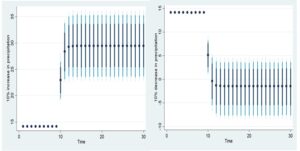The evidence is clear: Ghana’s food insecurity has been greatly increased due to climate change causing prolonged dry seasons, rising temperatures across all ecological zones, and low rainfall. Modelling its implications on food security is therefore crucial for reducing the agriculture sector’s vulnerability to climate change and mitigating its negative consequences.
What is the nexus between climate change and food security?
A recurrent theme in the climate change and food security research literature is that climatic factors such as carbon dioxide emissions, temperature and precipitation are having a detrimental effect on food production globally. Precipitation and temperature are having an adverse and highly significant impact on maize and soybean productivity in both short- and long-term assessments. Whereas temperature is the most important component in rain-fed settings, precipitation is the most important element in irrigated crop areas.
The impact of climate and carbon dioxide emissions on maize and soybean crop output has also been extensively studied, and the outcome is that carbon emissions have a deleterious influence on the availability of food. According to research, food supply and security will be seriously harmed if little or no action is taken to combat climate change and the food system’s susceptibility to climatic changes.
Although Ghana is aware of climate change and the consequent environmental and food production concerns, there is insufficient financing to adopt the essential mitigation and adaptation measures. Furthermore, as a holistic response to climate change, Ghana’s National Climate Change Policy establishes a clear path for dealing with the danger within the country’s socioeconomic framework, even though it looks to be deficient in terms of execution much less sustainability. As a result, it is critical to research the effects of climate change on developing countries like Ghana where agriculture is the primary source of income
What did the new study look at?
Previous studies have highlighted that Ghana’s agricultural industry is subject to climatic variation and change since it depends on rainfall, and this has resulted in the sector’s low productivity. Only 2% of Ghana’s irrigation capacity is used, and a majority of the country’s agriculture is still dependent on rain-fed cultivation. Other studies have pointed out that erratic precipitation patterns have serious effects on food productivity, and temperature rises are reducing the production of major crops. The Ghanaian economy relies heavily on maize and soybean production. The entire maize and soybean production system is low-tech, making it extremely susceptible to environmental factors.
As a result, climate change and variability have an influence on agricultural production – such as maize and soybean yields. So, to offer an important policy for improving climate change mitigation and adaptation techniques, as well as improving crop yields and working towards food sustainability, this study examined the long- and short-term linkages between carbon-dioxide emissions, domestic credit, precipitation, and fertiliser application on maize and soybean productivity.
The data for this study came from Ghana’s annual time-series data, which spanned 31 years from 1990 to 2020. Data on maize and soybean production come from the Food and Agriculture Organisation (FAO), while CO2 emissions, precipitation, domestic credit and fertiliser consumption come from the World Development Indicators (WDI). First, the research used the Autoregressive Distributed Lag (ARDL) bounds testing model to look at the co-integration link among the variables. The dynamic simulated the ARDL technique that simulates, estimates and automatically plots the predictions of one independent variable on the dependent variable without interfering with outcomes of the other variables also employed for this study. This study further used the frequency domain causality to gauge the causality relationship among the variables.
What did the study find?
Through a trend analysis, the study first found that maize and soybean production and the area harvested have on average been on the rise since 1990; however, since 2016 maize and soybean production and the area harvested have experienced a sharp increase as compared to the previous years. The sharp increase was attributed to the ‘Planting for Food and Jobs’ policy that the government of Ghana implemented in 2017, which aimed at enhancing on-farm productivity by increasing fertiliser subsidies and adopting hybrid seeds for specific crops. However, Ghana’s high temperatures, poor rainfall and drought in most farming communities cause poor productivity at 1.8mt/ha – compared to 4.26mt/ha, 3.49mt/ha, 3.47mt/ha, and 3.39mt/ha for Turkey, Italy, the United States of America and Brazil respectively for soybean production.
Using maize production as an example, the findings show that carbon-dioxide emissions have a statistically significant positive effect on maize yield in both the short- and long-run. In both the short- and long-run, a 1% increase in carbon-dioxide emissions increases maize production by 0.599% and 0.611%. Lending domestically has a statistically significant adverse effect on maize output in both the short- and long-run.
In the short- and long-run, a 1% increase in domestic credit reduces maize output by 0.287% and 0.479%, respectively. Fertiliser application has a minor adverse impact on maize output in the short-term, but a considerable negative impact on maize production in the long-term. A 1% increase in fertiliser application reduces maize output by 0.030% in the short-run and 0.085% in the long-run, respectively.
Furthermore, precipitation has a statistically significant positive impact on maize yields in both the short- and long-run. A 1% increase in precipitation boosts maize production by 1.297% in the short-term and 0.885% in the long-run. For instance, the impulse response analysis displayed in the Figure below reveals that a 10% increase in precipitation enhances maize output in both the short- and long-run, while a 10% decrease in precipitation boosts maize output in the short-run but decreases it in the long-run.

In terms of soybean production, the data show that carbon-dioxide emissions and lending domestically have insignificant stimulus on yield in both the short and long ranges; however, fertiliser application and precipitation have a statistically favourable impact on yield in the short-run. According to the research, a 1% rise in carbon-dioxide emissions enhances soybean output by 0.035% in the short-term and 0.028% in the long-term.
A 1% increase in domestic credit boosts soybean production by 0.048% in the short-run, while in the long-run it decreases soybean production by 0.241%. Again, the study found that increasing fertiliser application by 1% enhances soybean yield by 0.115% and 0.022% in the short- and long-run respectively. Furthermore, a 1% increase in precipitation boosts soybean yields by 0.969% in the short-term and 0.351% in the long-run, according to the study.
What are the policy implications?
The findings highlighted above indicate that because irrigation is a potential remedy for ensuring a consistent water supply and mitigating heat stress, it is critical to expand the use of groundwater irrigation in measuring the carbon-dioxide emissions of agricultural production and underpinning the prospects for their reduction to sustainably develop farming strategies that increase yield with a minimal environmental cost.
The findings imply that no-tillage intercropping with plastic film mulching and straw covering is the most practical and efficient cropping production method that needs to be researched, as intercropping has been found to increase crop yield and make better use of land.
Domestic lending to maize and soybean farmers should enhance productivity; but, due to high lending rates, most farmers are unable to reap these gains. A previous study has revealed that farmers who have access to little or moderate agricultural credit have an 8% higher probability of boosting technical efficiency than those who do not have access to credit.
The need for farmers to create cooperatives and form better partnerships with financial institutions to boost production, and governmental initiatives aimed at expanding smallholder farmers’ access to domestic financing, should be pushed aggressively. Above all, interested parties should make it easier to get better seedlings and fertiliser, financing, farm technology, and short-term training. The findings imply that to improve fertiliser use for sustainable food production, focused outreach of extension services be explored to promote fertiliser use and increase yields in less-productive regions, as well as regulations which integrate provisions for weather shocks. Again, to increase farmer-knowledge and future yields in Ghana, it is necessary to invest in improving climatic data.
In conclusion, although the findings of this study showed that CO2 emissions enhance maize and soybean production, it is still important for policymakers to promote climate-resistant maize and soybean varieties in Ghana. Domestic credit has an important role in increasing maize and soybean production; consequently, this research advises that financial institutions should provide low-interest financing to agricultural communities – with easy installments so that farmers may reap the benefits of climate change adaptation.
This study discovered that fertiliser application has an impact on maize and soybean production; as a result, fertiliser use should be increased – nevertheless, the type of soil is also a major factor in deciding the type and timing of fertiliser application. Crop and water management strategies, as well as information availability, should be considered in food production so as to improve resistance to climate change and adverse climatic circumstances.
Reference:
Ntiamoah, E.B., Li, D., Appiah-Otoo, I. et al. Toward sustainable food production: modelling the impacts of climate change on maize and soybean production in Ghana. Environ Sci Pollut Res (2022). https://doi.org/10.1007/s11356-022-20962-z
The writer is a food security and climate policy analyst. His research focus on accelerating climate action in food systems, and research interests include climate vulnerability and change, food security, agriculture economics, and agribusiness. He can be reached on [email protected]










